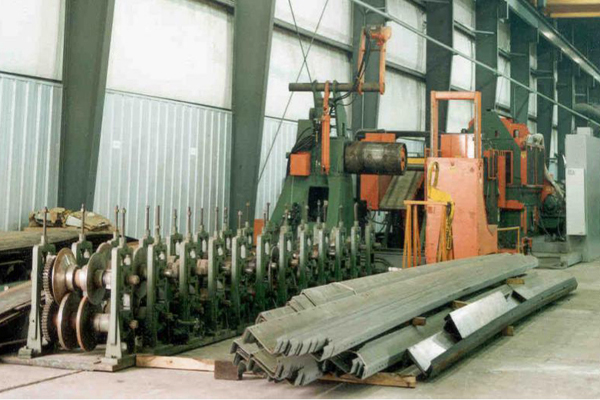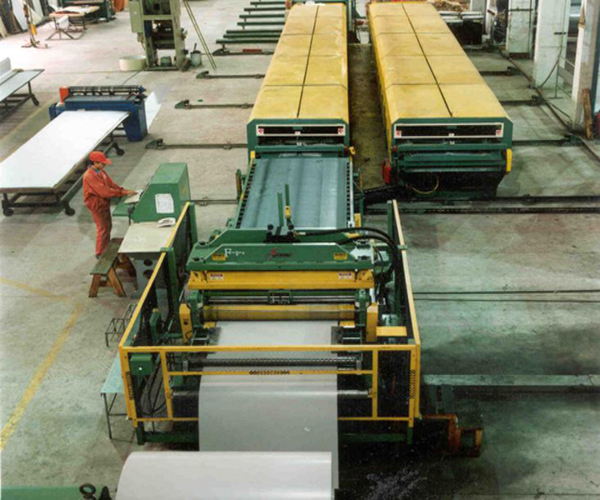The manufacture of steel structure surrounding system
- 27 Dec 2019
- steel structure
The processing and manufacturing of roofand wall protection systems for steel structure factories mainly include the processing of roof purlins, wall beams, roof color steel plates, wall color steel plates, and roof drainage gutters.
1. Processing of steel structure plant purlin
Roofing purlins are mainly Z-shaped purlins. The purlins are processed by the purlin forming automatic production line for one feeding and one molding. The shaped purlins must be smoothed and finished at the ends.
1.1 The main process of purlin processing
get material → rolled up → correct flat → make holes → cut down → forming → marking → package → Product storage
1.2 Control points of purlin processing
1.2.1 Raw material inspection
Visually inspect the appearance quality of the steel strip. The surface of the steel strip must be free of scars, cracks, inclusions, and other defects that are harmful to the use.
The size and unevenness of the steel strip are measured with tools such as a steel ruler.
The surface quality of the steel strip is inspected with the naked eye and a 10x magnifier, and cracks observed with a 10x magnifier are not allowed. The surface of the steel strip must be free from coating peeling and scratches that affect its performance.
1.2.2 Processing molding
The production of purlins is mainly carried out by C-type purlin forming machine, and the process requirements during bending should be paid attention to.
After the first piece is processed, a comprehensive inspection must be performed to confirm the combined requirements of size and specifications before large-scale component processing can be performed.
When bending, it is necessary to gradually bend the shape one by one to avoid pressing with great force at the same time, and finally check it with a template. Do not bend too much at one time, causing reciprocating bending and damaging the component.

Figure: Purlin Production Line
1.2.3 Quality control of finished products
The surface defects of the purlin due to molding must not exceed half of the thickness tolerance specified in the original sheet. Inspection by the naked eye and a 10-times magnifying glass, the surface of the component should be free of defects such as burrs and cracks.
Section dimensions: The cross-section dimensions of purlins should be measured with steel rulers and calipers. When measuring the wave height, the upper flange should be kept horizontal and the wave distance adjusted to the specified size. The allowable deviation of the cross-section dimensions of the purlins is specified in the following table:
The main control and inspection contents of purlins in the factory are:
| Test items | Deviation control |
|---|---|
| Length | Not more than±2mm |
| Bend | No more than 1/1000 with no more than 3mm |
| Height | Not more than ± 1mm |
| Appearance | No visible damage |
2. Production of profiled steel plates for steel structure workshops
The profiled sheet is processed by the sheet molding machine at one time. The equipment should be debugged before processing. After the first piece is processed, a comprehensive inspection must be performed. The main contents of the inspection are:
2.1 Whether there is dirt on the surface: defects such as damage, deformation, scratches, warping, and damage.
2.2 Check whether the labels of the required color plates are consistent with the requirements.
2.3 The color plates that meet the requirements are mounted on the uncoiler with a forklift, and are uncoiled. The uncoiled width error of the color steel coil is not greater than 3mm.
2.4 Manually remove the non-standard color plates at the beginning of the unwinding.
2.5 Drag the color plates that meet the standards into the molding machine, and slowly start the machine to form. The color plate is slowly formed in the forming track to the cutting machine.
2.6 Cut off the "headboard" and enter the length and quantity of the required board.
2.7 Check the quality and length of the first plate produced.
2.8 The profiled steel plate after forming must meet the standards of "Profiled Steel Plate for Construction" (GB / T12755-91). The allowable deviation is shown in the table below:
| Items | Allowable deviation | Testing method |
|---|---|---|
| Board length | 0-10mm | Steel tape |
| Board width | ±8mm | Steel ruler |
| Wave height | ±1mm | Template |
| Sickle bend | Not more than 20mm | Steel ruler, construction line |
2.9 50 sheets of plate products that meet the requirements are packed in plastic film for each package, and each package is packed with packing tape.
2.10 Stacking: The stacking site should be level, and stowage should be used to make the board about 200mm away from the ground. Stalls should be level and the spacing should not be greater than 2m.

Figure: Profiled steel sheet forming
3. Control of profiled plate after forming in factory
3.1 Handling: Bundles of steel plates are loaded on the truck and stored in the factory. You cannot directly use a hook and a triangle to form a triangle between the steel plates. Instead, you must use a boom, a rope, and the steel plates and the bars to lift vertically. It should be found after lifting balance point. To lift a single bundle, handle it carefully. The steel plate cannot be towed. When carrying a single steel plate, depending on the length of the plate, it needs to be carried by 3 to 5 people, so as not to deform the steel plate. When hoisting, the board should be placed on the roof according to the installation direction to avoid the steel plate from turning on the roof. Do not drag the steel plates on the surface of the object during transportation, or drag the steel plates to each other, so as not to damage the topcoat.
3.2 In-plant storage and storage: When stored in the factory, it should be stored with sleepers or base materials, and the steel plate should not be in direct contact with the ground to avoid water ingress. The product should be tilted by 2 to 5 degrees when the product is elevated, even if rainwater enters, it can flow out in time. If it is placed outdoors, it must be completely covered with a tarpaulin; if water enters between the boards, it should be separated one by one and dried before being stacked.
3.3 The profiled steel plates should be stacked away from other bare steels to prevent the rustable materials on these steels from falling down and adhering to the steel plates, which is difficult to remove, causing rust spots and penetrating the steel plates.
3.4 When steel plates are stacked, each stack cannot exceed four boxes, and heavy objects and stepping on steel plates cannot be placed.